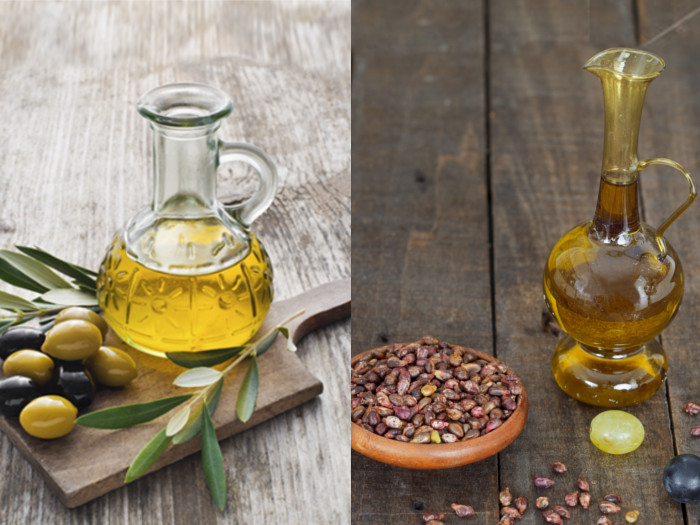
It’s derived from rapeseed plants.Ī 2013 review suggests that canola oil could help reduce LDL (“bad”) cholesterol and even improve insulin sensitivity. But don’t worry, canola oil isn’t created with test tubes in a lab. The “can” in “canola” stands for Canada, where this oil was developed in the 1970s. Any of these single-source oils makes for nutritious cooking, dipping, and more. As for olive oil? Loads of research definitively supports its anti-inflammatory properties.īesides oils from olives and veggie blends, there’s a whole lineup of other healthy plant-based fats just waiting to join your pantry’s roster. The jury is still out on whether vegetable oil blends are actually anti-inflammatory - though a 2014 review concluded that they didn’t increase inflammation. The likely explanation for these oils’ effects on disease comes down to one major factor: their ability to quell (or at least not promote) inflammation.
#Fhash point canola oil vs olive oil skin
Other studies have suggested that olive oil can help prevent colorectal cancer and skin cancer. A 2015 research review on breast cancer found that, while vegetable oils weren’t associated with a higher risk of breast cancer, olive oil might go the extra mile and protect against it. While we’re talking disease, cancer is worth a mention too. The research on vegetable oils for heart health is a bit less clear-cut.Īccording to the American Heart Association, replacing saturated fats (like butter) with the unsaturated fats in vegetable oils significantly reduces the risk of cardiovascular disease - but some research has proposed that veggie oils high in omega-6 fatty acids could actually drive heart disease. A large-scale 2020 study found that higher olive oil intake was linked to lower risk of cardiovascular disease and coronary heart disease in both men and women. Research has been conducted on their effects on everything from heart health to acne, with points in both oils’ favor.Īs for your ticker, olive oil appears to have an edge over vegetable.

There’s a lot to unpack when it comes to which oil is better for you. Less-processed extra-virgin olive oils usually contain significantly more micronutrients, such as vitamins E and K. Processing of vegetable oils tends to remove naturally occurring anti-inflammatory compounds like polyphenols and tocopherols. What a nutrition facts label can’t tell you, of course, is how processed a food is. The same amount of vegetable oil has 1 gram saturated and 13 grams unsaturated. In 1 tablespoon of either extra-virgin olive oil or a canola-soybean oil blend, you’ll find the following:Īs for the specific types of fat in each, 1 tablespoon of EVOO contains 2 grams of saturated fat and 12 grams of unsaturated fat. NutritionĪll pure fats contain 9 calories per gram (and no carbs or protein), so most points on the nutrition facts labels of olive and vegetable oils will look the same. (Ever notice that vegetable oil doesn’t really taste like, well, anything?)Īnyone who’s ever dipped a crusty slice of bread into a quality olive oil, on the other hand, can instantly recognize its signature olive-y taste, left relatively untouched by processing. Research suggests that this amount of processing diminishes antioxidant content in veggie oils. For that reason, vegetable oils require more processing than olive oils. While both olive and vegetable oil blends must be heated and treated with chemicals to remove impurities, it takes quite a bit more effort (aka processing) to blend and refine multiple vegetables into a single oil.


To fill a bottle with their oils, manufacturers put these plants through a process of extraction and refinement. Plants like corn, soybeans, and even olives aren’t exactly dripping with oil right off the stalk or tree. vegetable oil: Breaking down the differences Processing and flavor


 0 kommentar(er)
0 kommentar(er)
